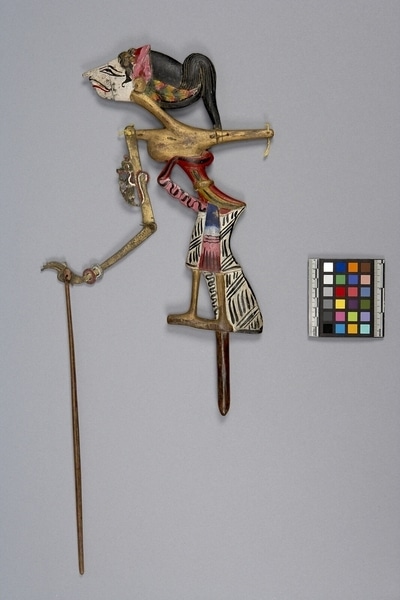Shadow Puppet Item Number: Ib360 from the MOA: University of British Columbia


Description
Two-dimensional human male in low relief. Body in three pieces: one major component with extensions attached to left shoulder and face. Single long arm to right, tied to shoulder with yellow cord, jointed at elbow, tied to controlling rod at palm. Long pointed white face positioned forward: hair, beard, small eyes, and moustache painted in black. Headdress a downturned curl with pink diadem (jamang) and green and red sumping. Neck, shoulders, and arm gold. Elaborate decoration at bicep and two ornaments at wrist (green and red). Hand held with all fingers touching thumb. Red garment covering lower torso with gold belt and white and black skirt with blue apron at front.
History Of Use
Javanese puppetry as an art form probably developed by the 11th century. Wayang klikit puppetry is a minor form of shadow theatre. Originally the plays depicted Javanese mythology, but after contact with India the Hindu epics, Ramayana and Mahabharata, became predominant in the cycles, which comprise about 200 plays. A dalang (puppet master) performs the plays to celebrate important occasions, usually in three acts, with vocal and instrumental accompaniment. Typically they serve a moral and religious purpose. Although the custom varies, men typically observe the plays on the dalang's side of the screen, thus directly partaking of the spiritual elements of the drama. Women and children are excluded, watching only the shadows from the opposite side of the screen. Each puppet's character is represented by its appearance and placement onstage; good characters are placed to the right, evil to the left.
Iconographic Meaning
Each puppet is characterized by it's wanda, a Javanese word which describes the specific mixture of elements of size, form, colour, ornamentation and carving. White face, shape of body and face, and garments are distinguished features. Position of face implies some contrariness to spiritual order. Gold skin suggests youth or calmness. Position of hand unusual. Character not identified, although he may be a minor prince or noble.
Cultural Context
Theatrical performance.
Item History
- Made in Java, Indonesia
- Owned by Tradewind Antiques before March 15, 1983
- Received from Museum of Anthropology Shop Volunteers (Funding source) and Tradewind Antiques (Seller) on March 15, 1983
What
Who
- Culture
- Javanese
- Previous Owner
- Tradewind Antiques
- Received from
- Museum of Anthropology Shop Volunteers (Funding source) and Tradewind Antiques (Seller)
Where
- Holding Institution
- MOA: University of British Columbia
- Made in
- Java, Indonesia
When
- Ownership Date
- before March 15, 1983
- Acquisition Date
- on March 15, 1983
Other
- Condition
- poor
- Accession Number
- 0886/0094